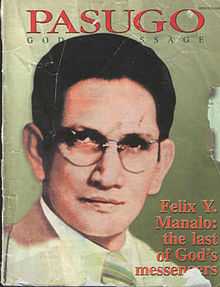Felix Manalo
| Felix Ysagun Manalo | |
|---|---|
 Felix Y. Manalo on the cover of Pasugo | |
| Religion | Iglesia ni Cristo |
| Personal | |
| Born |
May 10, 1886 Taguig, Philippines |
| Died |
April 12, 1963 (aged 76) Quezon City, Philippines |
| Senior posting | |
| Based in | F. Manalo, San Juan City, Philippines |
| Title | Huling Sugo ng Diyos sa mga Huling Araw ("The Last Messenger of God in these Last Days")[1] |
Period in office | 1913-1963 |
| Successor | Eraño G. Manalo |
Felix Ysagun Manalo (born Félix Manalo ý Ysagun May 10, 1886 - April 12, 1963), also known as Ka Félix,[2] was the founder and first Executive Minister (Filipino: Tagapamahalang Pangkalahatan) of the Philippines'-based religious organization Iglesia ni Cristo, and incorporated it with the Philippine Government on July 27, 1914. He is the father of Eraño G. Manalo, who succeeded him as Executive Minister of the Iglesia ni Cristo, and the grandfather of Eduardo V. Manalo, the current Executive Minister.
Because there were no precursors to the registered church, external sources and critics of the Iglesia ni Cristo refer to him as the founder of the Iglesia ni Cristo and describe him as such.[3] The official doctrine of the Iglesia ni Cristo is that Felix Y. Manalo is the last messenger of God, sent to reestablish the first church founded by Jesus Christ, which the INC claims to have fallen into apostasy following the death of the Apostles.[4]
Biography
Felix Y. Manalo was born in Barrio Calzada, Tipas, Taguig, in Rizal province, southern Luzon, in the Philippines on May 10, 1886. He was raised in the Catholic faith by his parents, Mariano Ysagun and Bonifacia Manalo. (It was sometime after his mother’s death that he decided on his mother’s name over his father’s name.
In 1911, he joined the Seventh day Adventists wherein he also became a pastor. Then Manalo remarried. His second wife was Honorata de Guzman of Sta. Cruz, Manila. The couple were both active in the Church’s activities, Felix Manalo as a minister and Honorata, a deaconess. But then, after pondering on the Adventist’s persistent observance of Sabbath, Manalo found it unscriptural.[citation needed] He abandoned the Adventist Church and returned to his hat shop. According to a source, Manalo was reportedly suspended by the Seventh Day Adventist for alleged adultery.
Foundation of Iglesia ni Cristo
On Nov. 1913, Felix Manalo with his wife, Honorata, left their home in Pasay and headed for Punta, Sta. Ana, Manila to begin preaching about the Church of Christ (Iglesia ni Cristo). There he started with four or five listeners in a small room at the workers’ quarters of Atlantic Gulf and Pacific Company of Manila, Incorporated. As the listeners began to grow in number the nightly religious meetings moved out in the open. Soon, the first converts were baptized in the nearby Pasig River.
In his hometown, he met stiff persecutions. His town mates could hardly believe that so familiar a figure as he could bring no less than the message of salvation to them. They derided him. Yet some of the more determined detractors were later converted. Among these were Justino Cassanova, pastor of the Christian and Missionary alliance and Norbeto Asuncion who became ministers of the Iglesia ni Cristo.
On July 27, 1914 the Iglesia ni Cristo was officially registered with the Philippine government with he himself as the first Executive Minister.
A few months later, the Church’s work of propagation was launched in the town of Pateros and then in the town of Pasig. The propagation of the Church first began in Tondo, Manila in the closing months of 1915.
Trusted ministers were assigned to pioneer in the work of propagating the faith in the areas surrounding Manila. The church branched out to the provinces in Central Luzon. In 1937, the church began propagating in the Visayas when Manalo sent Alipio Apolonio to pioneer in preaching the church in Cebu, whence it hopped from one Visayan Island to another.
During the wartime period, when the Japanese Imperial Army occupied the Philippines, the mission of salvation continued in spite of the reign bombs and threats. While other religious groups compromised, out of fear, with the Japanese and succumbed to the machinations of the enemy, the Iglesia ni Cristo continued to hold worship services, continued to hold missionary campaigns and continued to minister to the spiritual needs of the brethren.
- ↑ "sugo". s´ugo' n. messenger n. 1 one sent: sugo 2 a messenger in a firm: mensahero 3 a bringer of news: tagapagbalita, taga- hatid ng balita. TAGALOG DICTIONARY. Retrieved 2008-12-07.
- ↑ "Tagalog - Dictionary: ka". Retrieved 4 April 2013.
- ↑ Suarez, E.T. (July 27, 2008). "Officials celebrate with Iglesia ni Cristo on its 94th anniversary". The Manila Bulletin Online (The Manila Bulletin). Retrieved 2008-11-10.
- ↑ Cantor, Marlex C (May 2005). "The Church After the time of the Apostles, His choice, not ours". Pasugo - God's Message (Quezon City, Philippines: Iglesia ni Cristo) 57 (5): 28–31. ISSN 0116-1636.
External links
| Wikimedia Commons has media related to Felix Manalo. |
- NHI marker
- Coordinates: 14°32'0"N 121°4'45"E
- Richard Gomez to portray Iglesia Ni Cristo founder Felix Manalo in biopic
| Preceded by None |
Executive Minister of Iglesia ni Cristo 1914 – 1963 |
Succeeded by Eraño G. Manalo |
| |||||||||||||||||||||||||||||||||||
|
